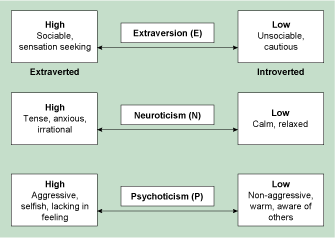2.1.1 The Eysenck Personality Questionnaire
In a later version of his theory, Eysenck added another component, psychoticism, also referred to as ‘P’. People who scored highly on the P scale were aggressive, lacking in feeling and antisocial, while those with a low P score were warm, caring and non-aggressive. Eysenck updated the personality scale to include the P dimension in the Eysenck Personality Questionnaire (EPQ) (Eysenck and Eysenck, 1975).
Eysenck thought that most people would score in the middle of the E and N scales, but at the lower end of the P scale. However, criminals would score at the higher end of each of the scales. Eysenck believed that there was a biological basis for personality and that extraversion and neuroticism related to arousal from the nervous system (biological approach). People who scored highly on the E scale (extraverts) had low arousal levels, therefore they would seek arousal from their environment, such as socialising and thrill-seeking activities. Whereas those who had low scores on the E scale (introverts) already had an over-aroused nervous system and therefore would seek out situations that minimised or reduced their arousal, such as reading a book. People who scored highly on the N scale had a nervous system that was more easily aroused or reacted more strongly to stressful situations (Eysenck, 1964).
Eysenck suggested that the link between personality and antisocial or criminal behaviour was due to differences in learning during childhood. According to the theory, as children grow up they learn right and wrong behaviours by developing a conscience. A conscience develops through conditioning, where unapproved or wrong behaviours receive punishment or disapproval. Therefore, children learn to avoid behaviours that will lead to punishment or disapproval and control their impulses. Children who were higher on the E and N scales would find it more difficult to learn during childhood, as they were harder to condition. As a result, those with higher E and N scores may not develop a conscience, or correctly learn right from wrong, and may have problems with controlling their impulsive behaviour. Then in later life, those who had not developed a conscience, and had a tendency towards impulsive behaviour, may be more likely to act in antisocial ways and commit crime. Eysenck suggested that according to his theory, offenders would score more highly on each of the three scales of the EPQ, as compared to non-offenders.

Activity 4
Questionnaires are a good research method to use when you want to collect data from a large number of people. Many questionnaires can be given out for people to complete and return, or respondents can be emailed a link to an online survey.
- Can you think of any problems in using a questionnaire to research an issue?
- What if you didn’t want someone to know how you really felt about an issue, or behaved in a particular situation, because you were embarrassed or ashamed?
- Do you think you would answer all the questions truthfully?
Discussion
One of the problems with using a questionnaire to collect data is that people may not tell the truth, as they want to be seen in a good light and favourably by others. This is the social desirability effect, whereby good behaviour is over-reported and bad behaviour is under-reported. This can really influence the findings from research, as it may not reflect the true frequency of behaviour.
To try and determine whether respondents were telling the truth when completing the EPQ, Eysenck included a Lie (L) scale. In the L scale, there are items that try to determine whether the respondent is giving the socially desired response or telling the truth. For example, a question on the L scale could be something like ‘I always try not to be rude to people’. A high score on the L scale is thought to indicate that the respondent is giving the socially desired response; a low score may indicate indifference to social expectations, as the respondent is not thinking about responses that are socially desirable. Therefore, those who have a propensity towards antisocial and criminal behaviour may have low scores on the L scale, as they do not think about what is socially desirable behaviour (Eysenck and Gudjonsson, 1989).

